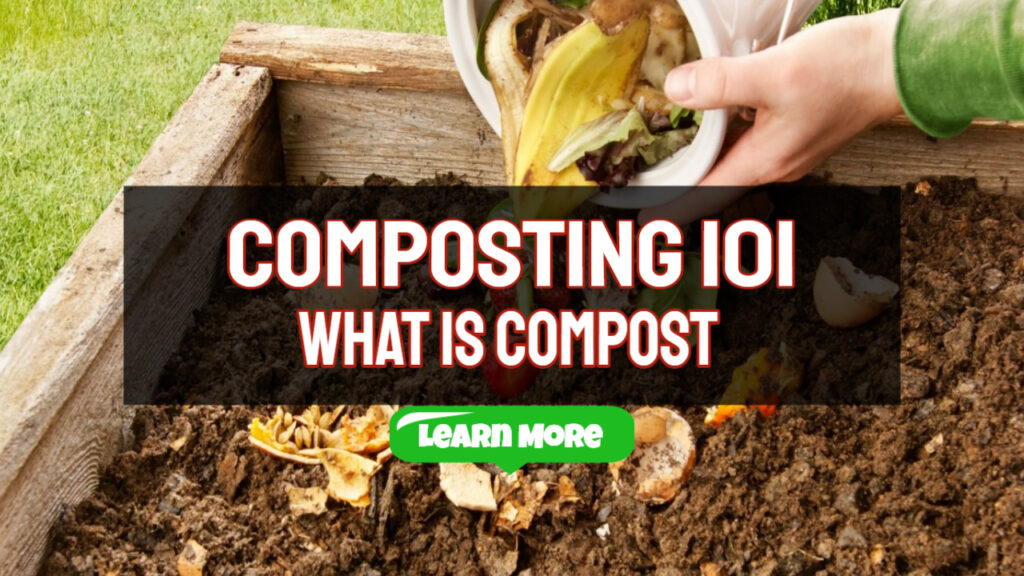Composting 101
Composting has been demonstrated to significantly reduce the amount of food wasted and thrown away [1]. It is one of the most important options for organic waste. It can be used for a variety of things, including turning trash into valuable commodities and preventing waste accumulation.
The breakdown of solid organic molecules in a controlled setting is known as composting. We also have access to critical information during this procedure. It’s a two-for-one win for humanity!
Human activity is mostly responsible for the depletion of essential elements in the ecosystem. There are numerous undesirable repercussions that could lead to all living species living in an unhealthy environment. As a result, we must take specific steps to replenish these molecules as soon as feasible. Thirty per cent of the garbage we generate may be composted and then added to the soil to help plants thrive [2].
WHAT IS COMPOST?
Compost can be created from any decomposed organic material, including rubbish, manure, leaves, grass clippings, dead plants, and animals, and it can be used to enrich soil. They are judged worthless because of their appearance or the manner in which we dispose of them. They, on the other hand, serve as a resource.
TYPES OF COMPOSTING
The organism in question suggests different types of composting. Some bacteria utilise oxygen to perform their functions, while others do not. The organism in question may even be able to live without oxygen. Depending on your preferences, you can compost in one of three methods.
AerobicsAnaerobic
Vermicomposting
Composting via Aerobic Process
This composting method requires the presence of air in order for items to break down quickly.
Procedures:
Scrapes should be stored in a well-ventilated area.
Green matter high in nitrogen, such as grass clippings, should be added.
Pour water over it to moisten it, and flip it often.
Observation:
Aerobic bacteria can breed in scraps. When these bacteria visit, they feed on it and its nitrogen-rich green stuff. During this process, heat is generated, which also works as a catalyst, speeding up the entire process.
Downside
Aerobic composting necessitates a substantial quantity of space and water.
Composting in anaerobic conditions
Anaerobic composting is diametrically opposed to aerobic composting. In the absence of air, it is the process through which composts decay.
Procedures
Compost should be stored in an airtight container.
Mix in some nitrogen-rich material.
Avoid coming into contact with water.
Observation
Because of its activity, this culture attracts anaerobic bacteria and bad odours.
Downside
Suffocation may occur in decomposers who are not well acclimated to this type of airless environment.
Vermicomposting
Vermicomposting is a process that makes use of macro decomposers like earthworms. These animals use oxygen and moisture to compose themselves.
Procedures
Drop some non-acidic vegetable or fruit leftovers in there.
Keep an eye on how the creatures approach it.
Observation
The worm’s activity is indicated by a faint odour.
Composting’s economic significance
Landfills
When composting, a certain piece of land may be filled with the matter if the topography of such land is uneven.
Production of methane
The odour emitted by abandoned landfills [2] is a mixture of different gases produced by decomposers. One of them is a methane-containing hydrocarbon. It is extractable and economically storable.
Improves soil fertility
Composts have no effect on soil unless bacteria, fungi, and macro-decomposers such as earthworms are present. When compost is left on the soil surface, these decomposers consume it saprophytically. This process decomposes the compost, releasing vital minerals (nitrogen, iron, sodium, and carbon dioxide) that add to the soil’s fertility.
The benefits of composting on the soil cannot be overstated. As a result, gardeners, farmers, and agricultural corporations ensure that the fertilisers they produce contain a significant proportion of compost. It contributes to the important and minor nutrients required for proper plant growth. This improves the soil’s texture and structure. Farmers can also profit from enhanced yields due to the soil’s better able to retain the right amount of oxygen, nutrients, and moisture.
Composting’s Negative Effects
A few drawbacks are unavoidable, and here are a few of them.
Warming of the planet
Excessive air pollution
GHGs (greenhouse gases)
We know that the efferent of a composting matter is a mixture. Carbon dioxide emissions into the atmosphere build up. It hastens the depletion of the ozone layer, which is a layer in the upper atmosphere that keeps the sun’s harsh rays from reaching the earth’s surface. A rise in carbon dioxide causes a thermal impact on its own [2].
Pollution of the atmosphere
The stench perceived is hazardous to one’s health and could lead to illness.
Explosion
Methane is a flammable gas. An explosion could occur if the ambient temperature rises.
Composting is an effective way to remove rubbish from the environment or convert it to useable minerals. If you want to compost, you must first purchase a composter. Then, assess the advantages and disadvantages of your choice.
Brought To You By – Google Ranking Monster
References
[1] The United States Environmental Protection Agency. Types of Composting and Understanding the Process
[2] The United States Environmental Protection Agency. Composting At Home
The Article Composting 101 – What is Compost and Types of Composting First Appeared ON
: https://ad4sc.com
The post Composting 101 – What is Compost and Types of Composting appeared first on https://gqcentral.co.uk
The post Composting 101 – What is Compost and Types of Composting appeared first on https://alef3.com







Comments are closed